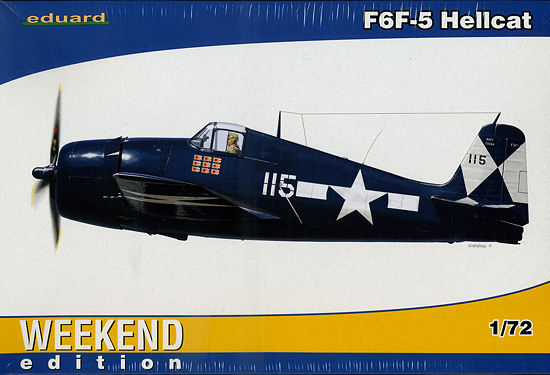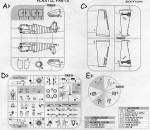
| KIT #: | 7415 |
| PRICE: | $16.95 SRP |
| DECALS: | One option |
| REVIEWER: | Scott Van Aken |
| NOTES: | Weekend Edition |

| HISTORY |
The Grumman F6F Hellcat was a carrier-based fighter aircraft initially conceived to replace the earlier F4F Wildcat in United States Navy (USN) service. Although the F6F resembled the Wildcat, it was a completely new design, powered by a 2,000 hp Pratt & Whitney R-2800, the same powerplant used for both the Navy's earlier Chance Vought F4U Corsair and the Army Air Force's Republic P-47 Thunderbolt fighters. Some military observers tagged the Hellcat as the "Wildcat's big brother". According to those who flew the Hellcat, it was pretty much vice-free and quite forgiving. Because it was so easy to fly and land on carrier decks, it was very successful in combat, allowing even a mediocre pilot to look good.
The F6F was best known for its role as a rugged, well designed carrier fighter which was able, after its combat debut in early 1943, to counter the Mitsubishi A6M and help secure air superiority over the Pacific Theater. Such was the quality of the basic simple, straightforward design, the Hellcat was the least modified fighter of the war, with a total of 12,200 being built in just over two years. Hellcats were credited with destroying 5,271 aircraft while in service with the U.S. Navy, U.S. Marine Corps and the Royal Navy's Fleet Air Arm This was more than any other Allied naval aircraft, with its closest competitor on the Allied side being the USAAF's P-51 Mustang, which claimed some 4,950 enemy aircraft shot down and a further 4,131 destroyed on the ground during the war in the European Theatre. Postwar, the Hellcat was phased out of front line service, but remained in service as late as 1954 as a night fighter. Several countries also flew the Hellcat post war, including France and Uruguay.
| THE KIT |
 Typical
of Eduard's weekend editions, this one has exactly the same plastic as their
more expensive Profipak kits. What is missing from this one are the two photo
etch frets, the canopy masks and three of the four decal options. Because the
photo etch is not included, you will have to come up with your own seat belts
and it affects how you can load your Hellcat, which I will touch upon later.
Typical
of Eduard's weekend editions, this one has exactly the same plastic as their
more expensive Profipak kits. What is missing from this one are the two photo
etch frets, the canopy masks and three of the four decal options. Because the
photo etch is not included, you will have to come up with your own seat belts
and it affects how you can load your Hellcat, which I will touch upon later.
The grey-green sprues are all superbly molded, as one expects of Eduard. I did notice some sink areas on a few of the thicker parts that will need to be filled. The interior is quite complete with a seat, instrument panel, side consoles and rudder pedals. The gun sight is molded onto the instrument panel. Such is the design of the kit that the area for the rear 'quarter windows' is an insert. You do get all the various bits to do a -3 if you so wish in terms of these windows as well as three different cowling side panels. However, the wings are for the -5 and already have the holes for the rockets drilled out.
The kit provides two different wing gun inserts and though they look the same to me, right down to the sink areas on them, they are apparently different. The engine is nicely done, though without the etched detail of the Profipak version. You are provided two different types of tires to place in between the separate wheel hubs. One is smooth and the other has circumferal tread. I did not see any of the equally common diamond tread tires included. For those who might want to use aftermarket resin wheels, these are exactly the same as used on the F4U Corsair.
For things under wings you have a drop tank as well as the
aforementioned rockets. While the plyons and bodies for the bombs (another
commonly carried item) are included, since the fins for the bombs were done in
photo etch, those cannot be used. You will need to go to the spares box or
aftermarket if you wish a bomb load. Two different canopies are included as
well, one for open and one for closed. The proper -5 windscreen is provided. I
should mention as well that the -3
windscreen is also on the clear sprue. As many of you know, the Hellcat variants
often had characteristics of later or earlier versions as the modifications to
the airframe were on-going so you would have -5s with the quarter windows, or
early canopy, or earlier cowling, as well as -3s with the later cowling.
that the -3
windscreen is also on the clear sprue. As many of you know, the Hellcat variants
often had characteristics of later or earlier versions as the modifications to
the airframe were on-going so you would have -5s with the quarter windows, or
early canopy, or earlier cowling, as well as -3s with the later cowling.
Instructions are well done with the usual Gunze paint references. The markings provided are one of the four from the Profipak kit and are for a named plane from VF-83 aboard the USS Essex in mid 1945. Decals are nicely printed and include the wing walk areas.
| CONCLUSIONS |
So, for about ten dollars less than the Profipak version, you get a very nice Hellcat. It is a shame that one cannot build it with the bombs and bomb pylons, but as I have seen in previous Weekend Edition kits, that is the price one pays for saving money.
| REFERENCES |
http://en.wikipedia.org/wiki/F6F_Hellcat
January 2013
Thanks to my pal Drew for getting this for me for Christmas
If you would like your product reviewed fairly and fairly quickly, please contact the editor or see other details in the Note to Contributors.